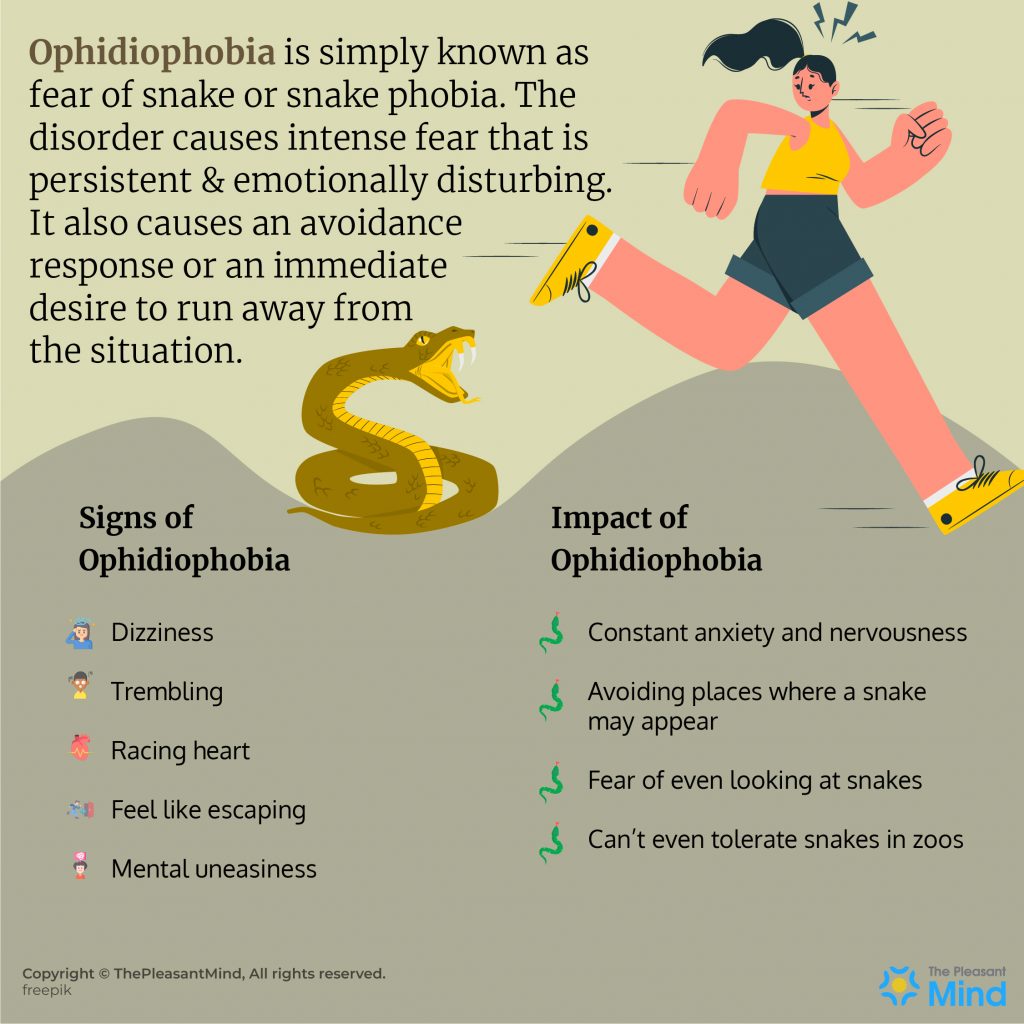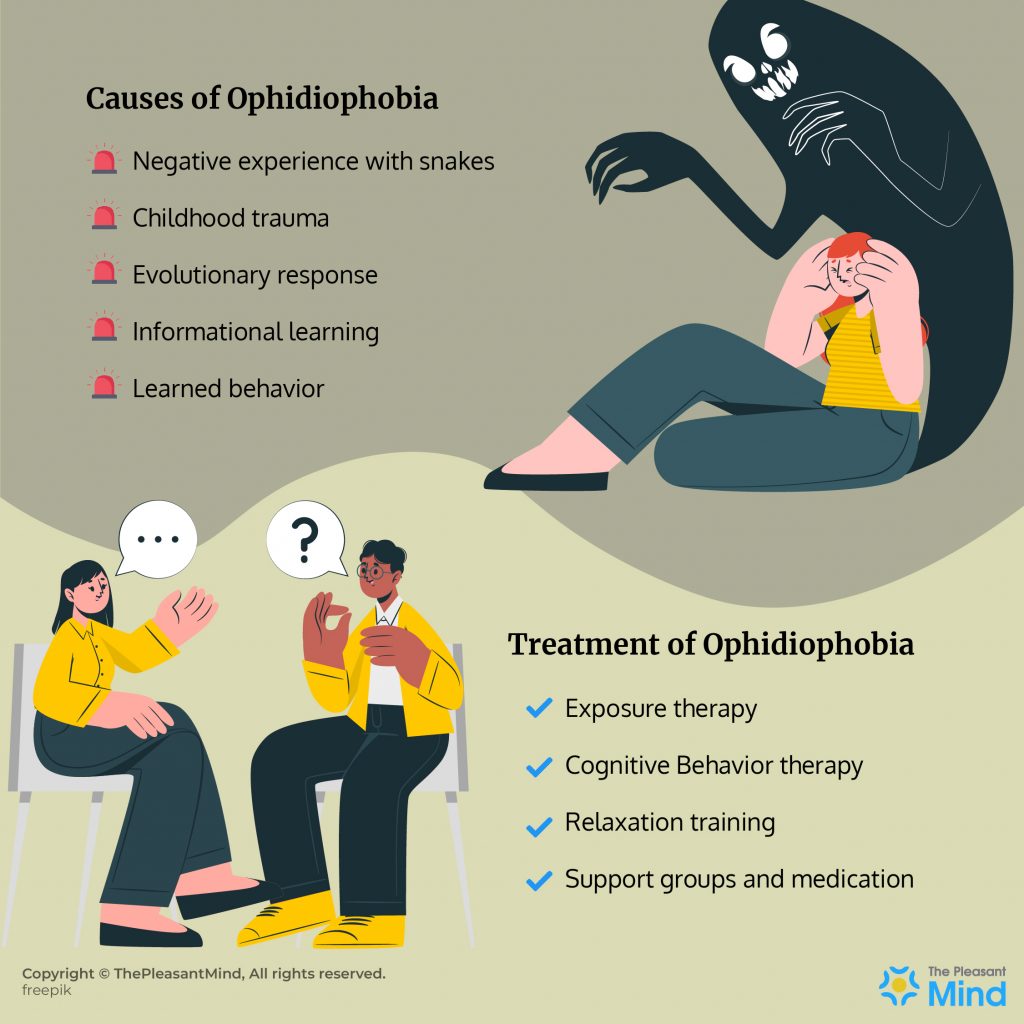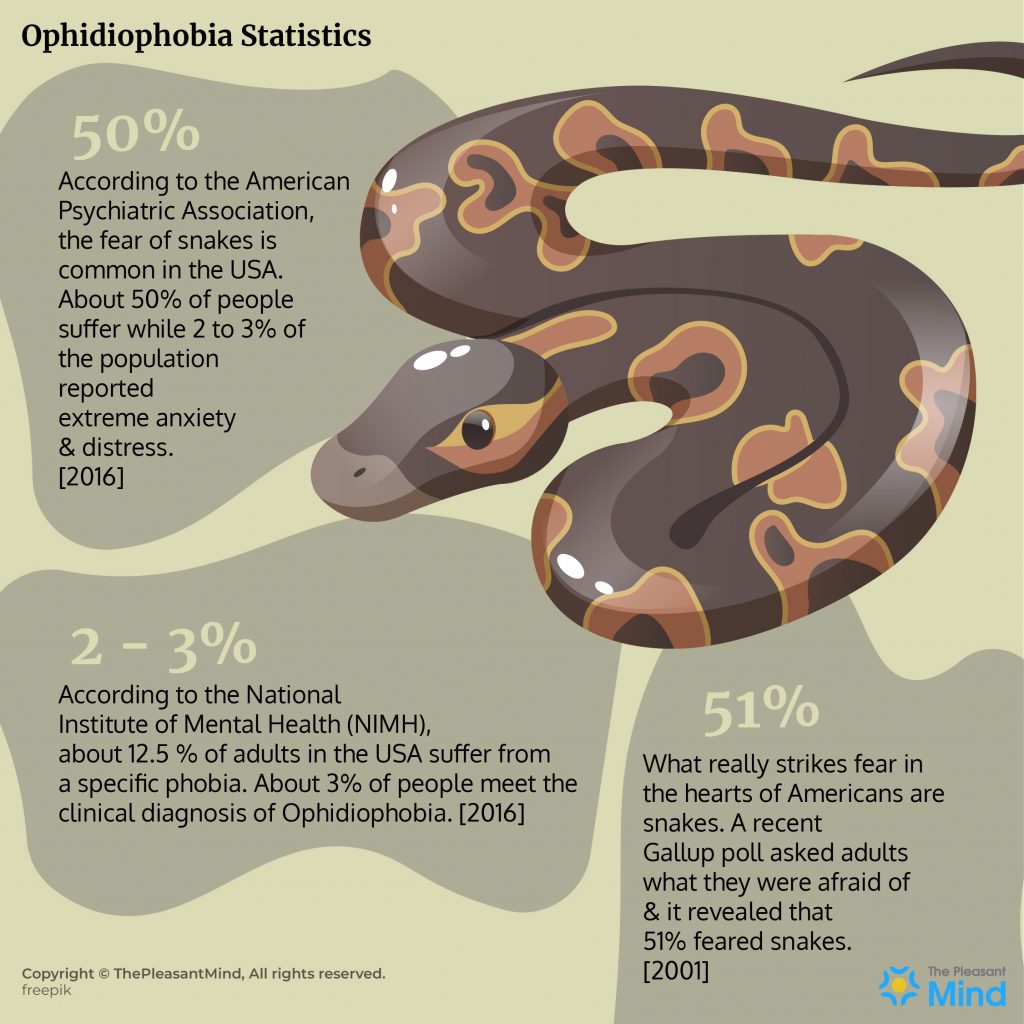
Key Takeaways
- Your phobia is more than a normal fear of snakes.
- Ophidiophobia is an irrational, persistent, and overwhelming fear response of snakes.
- It can bring a host of physical discomfort and psychological distress.
- The severe fear response can make you go to any extent to avoid snakes.
- Exposure therapy, cognitive behavior therapy is the usual line of treatment for Ophidiophobia.
- The anxiousness and emotional distress are out of proportion to the real threat. It also limits your normal functioning.
Fear of animals is the most common type of specific phobia. And if it’s a snake, the discomfort will be overwhelming.
Isn’t it so? We all have a slight to medium fear of snakes. But if your fear response is intense and extraordinary, it is known as Ophidiophobia.
This fear is common because most people suffering from this phobia can lead a normal life unless they encounter snakes quite frequently.
Over time, the fear gets worse and the person may display signs of panic attacks and emotional discomfort even if there is no actual snake around them.
If you are afraid of snakes that are getting worse day by day, you should seek medical advice to overcome the draining symptoms that are taking a toll on your mental health.
In this article, we will keep you informed about the signs of this illness, along with the causal factors and appropriate treatment methods that may help you face your fear bravely.
Stay informed…..
Ophidiophobia Infographics


What is Ophidiophobia?
SUMMARY
Ophidiophobia is an extreme, often baseless, and irrational fear response of snakes. The condition may worsen, if not treated because the symptoms are not related to little dislike or a slim disgust; but it is a full-blown panic condition. The sufferer goes through grievous experiences that are real and can’t be disregarded at all.
Ophidiophobia refers to phobia, where you suffer from an extreme fear of snakes. This term comes out of the Greek word ‘Ophio’, which means serpent or snake’, and the word Phobos’, which means fear.
It is usual for individuals to fear something or the other. But suffering from a normal fear of reptiles, and snakes, in particular, varies from having any phobia.
The person may have anxiousness about this creature that can be either poisonous or harmless.
Out of this large population, around 5% of those who fear snakes may be suffering from this problem of Ophidiophobia. They fear a snake winding around their body or a slithery slimy animal passing underfoot.
These thoughts are completely baseless and come out of fear alone. Thus, this illness is described as a phobia. The terror and dread response makes this fear response an extraordinary one.
Under this situation, the fear gets to such a level that it interferes with their daily lives. It can even hamper the feel-good factor within an individual.
Health experts treat Ophidiophobia similar to that of an anxiety disorder or a panic disorder.
Ophidiophobia symptoms
When you suffer from an intense fear of snakes, you may have several symptoms under different circumstances.
They can show up when you come close to them, think of them, or engage yourself with the media having snakes.
For instance, if your colleague shares a piece of news related to python during lunchtime, you become fearful.
Once the phobia reaches its peak, you might even get afraid of snakes, which are smaller in size. It could become impossible for you to look into the videos and pictures of snakes.
The symptoms of Ophidiophobia can occur in two forms. They are physical symptoms and psychological symptoms.
Physical Symptoms
The problem of Ophidiophobia can become so intense for some people that they can show some physical symptoms.
When one sees a snake, he/she may feel sick. The person may fear that snakes kill humans. Thus, these reptiles can’t be trusted at all.
The immediate fear response leads to body restlessness, breathing troubles, chest tightness, nausea, and vomiting.
These symptoms can interfere with their smooth running of daily activities. The usual alarm can cause the person to experience the following signs:
- Dizziness
- Trembling
- Racing heart
- Feel like escaping
- Mental uneasiness
- Tingling sensation in hands and feet
Following are the physical symptoms of Ophidiophobia that needs to be discussed in detail:
1. Lightheadedness
When someone suffers from a severe level of Ophidiophobia, he can feel as if he will faint and lose his balance. It seems like the environment around him is spinning, and he will soon become unconscious.
2. Difficulty in Breathing
Breathing difficulties come out of the chest tightness that leads to chest pain. You struggle for oxygen and hence start panting for breath.
It usually happens when you keep thinking of different circumstances where snakes might be close to you.
3. A rise in the Level of Blood Pressure
When you are anxious, it will always adversely impact your blood pressure. Anxiety releases stress hormones inside your body.
Those hormones cause an increased heart rate and narrowing down of the blood vessels. Both these changes cause a dramatic rise in your blood pressure.
4. Tremors
If you are a person under the influence of Ophidiophobia, people can even see you tremble in fear from time to time.
You can feel tremors all across your limbs, making it difficult for you to carry out day-to-day activities.
5. Paresthesia
Paresthesia is a condition where you feel a prickling or burning sensation in the hands, arms, feet, or legs.
The situation calls for immediate relief, which you can get from applying a cold compress on all those affected regions.
Psychological Symptoms
The psychological symptoms of Ophidiophobia can appear in a diverse manner. You can face a wide range of problems across various spheres of life, hence adversely affecting your lifestyle.
Apart from these, people can suffer from psychological problems like lack of control, feeling of impending doom, or fear of death.
This phobia restricts your ability to lead a normal life and carry out various routine activities.
You might avoid visiting places where there are chances of seeing snakes and even refrain from watching those channels on TV, which show scenes surrounding snakes.
Let us now discuss some of these symptoms and understand their impact on your life:
1. Lack of Clarity
When you suffer from the problem of Ophidiophobia, you know that the fear and anxiety do not make sense.
Unfortunately, you struggle to find an appropriate way and manage it. There is an uncertainty that fills your whole mind.
2. Hampers Lifestyle
This snake phobia adversely hampers your whole lifestyle. You might refrain from traveling to places where snakes are visible.
The situation might force you to behave abnormally either at work, school, or in social gatherings.
3. Look for an Escape Route
You are always on the lookout to escape from reality. There is no intention to face your fear and get over it. Avoiding situations involving snakes help you to stay in your comfort zone.
4. A Feeling of Doom
Ophidiophobia, the irrational fear of snakes, makes you feel as if you are about to face a dangerous situation very soon in your life.
The feeling of doom fills your mind and leads to a rise in negative thoughts. You feel as if danger is waiting to strike and change the dynamics of life.
5. Apprehensive of Losing Command
Another common symptom of Ophidiophobia is that the person suffering from this fear always feels he will lose control over life and not manage to keep things together.
These thought patterns are also taking their toll on you and adversely impacting your life.
Difference between normal fear of snakes and Ophidiophobia
We know that fear becomes a phobia when it is intense and goes on for a long time. Sometimes, this fear response may also be seen when there is no immediate real threat around the person.
Thus, in most cases phobia is an irrational and irrelevant fear that is triggered by a perceived threat. In the case of Ophidiophobia, this fear is also overwhelming and can worsen with time.
Here are the main differences between normal fear of snakes and Ophidiophobia
| Normal fear of snakes | Ophidiophobia |
| The normal fear may look like a dislike or disgust for the slithery reptile | Ophidiophobia is an intense and irrational fear of snakes that is bigger and enormous than a normal fear |
| The person may be scared when seeing snakes | This fear response may happen even if the person is thinking about snakes |
| The person may feel fearful if asked to touch a snake or get closer to them | Discomfort even if asked to look at the snake, sometimes on television or videos |
| May think about snakes after a person experiences a single encounter | Constant negative thinking about snakes |
| The person doesn’t change routine and daily activities to avoid meeting a snake | Constantly tries to avoid meeting a snake |
| Fear of poisonous snakes only | Irrational fear of all snakes even if the snake is in the zoo or animal reserve |
How can you diagnose Ophidiophobia?
Like all other specific phobias such as cynophobia, arachnophobia, Pyrophobia, the diagnosis of Ophidiophobia takes place based on symptoms mentioned in the Diagnostic and Statistical Manual of Mental Disorders-5.
This manual is a handy book published by the American Psychiatric Association (2013) for doing diagnoses by the clinician.
Professionals believe that they occur due to the combined effect of stress, trauma, brain chemistry, learned responses, and genetics.
The diagnostic criteria of specific phobias, animal types are used to identify the disease in an individual.
To be considered for a clinical diagnosis, the person has to suffer from this phobia or fear response for at least 6 months.
- Constant fear and anxiousness about snakes are unrealistic and irrational at times.
- The fear response can occur even with the thought of seeing a snake.
- Exposure to snakes causes a severe fear response that is just unmanageable.
- The person can realize that their fear is excessive and irrational but cannot cope with it.
- A constant desire to escape and avoid the feared object.
- The avoidance and distress can interfere with the person’s daily life, work, relationships, and social life.
- Frequent panic attacks and general body sickness out of excessive fear.
- The persistent fear continues for 6 months or more.
- The phobia cannot be described by any other mental health problem.
Impact of Ophidiophobia
Specific phobias, like Ophidiophobia, often cause a massive effect, allowing people to suffer from difficulties in different areas of life. You could wonder if your fear is genuine.
Accept your fear and carry out consultations with mental health experts to find an appropriate way to come out of this problem.
You must make sure to implement those as per the suggestions of professionals. If the problem persists, people can expose themselves to suffering from other issues.
They are as follows:
- Ophidiophobia can cause a lot of anxiety, showing physical and emotional responses accompanying anxiety.
- This kind of common phobia isolates affected individuals. They do not mix with a friend or family member who has a great interest in snakes, thus leading their lives in isolation.
- The phobia of a snake is quite embarrassing. You may feel embarrassed after seeing those reactions your friends make after knowing about your phobia.
- If you do not treat this fear on time, it can make you helpless. You may feel at a loss for not managing to control it. You feel as if you are losing grip over your life.
- Even looking at the snake whether in reality or virtually causes a lot of distress.
- The anxiety and nervousness keep the person on an alert mode even if there is no real threat.
- The person may not visit places where snakes may be found such as old buildings, jungle safari, filthy water bodies, etc.
- Seeing snakes in zoos or enclosed spaces, such as pet stores can also cause a lot of fear.
Causes of Ophidiophobia
A fear of snakes or Ophidiophobia comes from several causes, similar to other specific phobias. It can have more than one factor, each having a layer on top of another one.
It results in a latent fear converting itself into something that induces anxiety among individuals.
Following are some of the causes of Ophidiophobia:
Traumatic Experiences
Traumatic and negative experiences with a snake, particularly when you were young, could leave a long-lasting phobia of this creature in your mind.
It could be that a snake had bitten you, or you were present in a scary environment, which featured snakes, and you had a helpless feeling.
Learned Behavior
Learned behavior is one of the common causes behind the emergence of Ophidiophobia.
If you had seen people close to you show an extreme reaction to snakes that would automatically make you feel that snakes are much more dangerous than they are in reality.
Your reactions become directly proportional to how you have seen people surrounding them react to the circumstances linked with snakes.
Impact of family and parental teachings
Parents play a crucial role in influencing the behavioral patterns of their children. Some fears are genetic and passed down through inheritance.
One can easily imbibe the fear and anxiousness towards snakes from their parents and siblings.
Research suggests that people are more prone to develop specific phobias from family members than others.
Informational learning
This type of learning occurs when you receive information about the danger of snakes and reptiles from some outside source.
It is not direct learning but passive information that evokes the fear response.
For example, you may hear about incidents of snakes biting people from some daily new source, or a friend must have shared a fearful story of a snake attack with you.
Since you’re already suffering from Ophidiophobia, you will become more panicky after hearing such incidents.
Evolutionary response
Research findings have shown that fear of snakes could be a conditioned response to harmful animals.
Human evolution has taught us that some animals, especially snakes, lizards, are harmful and should be avoided.
We were taught from childhood to escape from the place, in case a serpent appears. This is an automatic survival mechanism that has been passed down through generations.
Thus, your fear of snakes could be a survival strategy in face of danger. Over time, it becomes a conditioned response and can turn into a full-blown panic attack.
How to overcome the fear of snakes (Self-help tips)
You can always get in touch with mental health specialists to take care of this problem, but there are some ways that can help you come out of this fear on your own.
Let us look at them below:
Spend Time with the Outside World
If you have been avoiding people due to your extreme fear of snakes, you must spend time with the outside world.
When you share your thoughts and feelings with others, it helps to keep your physical and mental health in a sound state.
It can help you get back in the groove; prevent your fear from getting worse, and slowly come out of it.
Gain Knowledge about Snakes
All snakes are not the same. Some are venomous, while others are harmless. Unfortunately, when you have Ophidiophobia, you do not differentiate between the types of creature fear in general.
It is where getting proper insight into the differences between poisonous snakes and harmless ones can minimize your fear to a large extent.
When you know that certain snakes will never cause any harm, you can relax and not look to avoid them out of fear.
After all, knowledge is power, and it will help reduce your anxiousness and gain more control.
Remain Cautious and Realistic
You need to understand the thin line between feeling less anxious and getting so comfortable with it that you get exposed to snakes of different types. It is better to stay cautious.
Unless you work at a zoo and know how to handle snakes, you should have a realistic target of seeing snakes from a distance.
Prevalence of Ophidiophobia
- Ophidiophobia is the most common type of reported fear worldwide because 1/3rd of the global population is scared of snakes.
- The survey done on the U.S population revealed that 51% of the country’s population is afraid of snakes, both poisonous and non-poisonous types.
- Davey (1994) found that 53.3% of people reported their fear of snakes, out of which 2 to 3% people are clinically diagnosed as suffering from Ophidiophobia.
- Another study was done by Fredrikson. et.al (1996) found that despite having a low number of snakes in the community, 5.5% of Swedish people suffered from Ophidiophobia.
Prognosis of Ophidiophobia
We have many effective treatment methods to deal with Ophidiophobia. And the recovery rates are quite promising.
The treatment may take time because it depends upon the severity of the condition. If the level of discomfort is mild or moderate success rates are more.
In severe cases of Ophidiophobia, the doctor may use a multi-modal approach to treat the fear response.
They may use medication, psychotherapy, lifestyle changes altogether to achieve the desired results.
Ophidiophobia is a treatable condition and some studies have confirmed that the success rate can even be 90% recovery.
Quick facts about Ophidiophobia
Some quick facts about Ophidiophobia are as follows:
- Many people have never met a snake in their life, yet they are scared of the reptile.
- Terror of snakes is common in Ophidiophobia, leading to a feeling of dying.
- Ophidiophobia is a diagnosable mental health condition.
- The fear is enormous in size and causes extreme emotional distress.
- People with Ophidiophobia may feel hesitant to seek treatment unless the condition worsens. They fear being mocked and ridiculed by others.
- Trembling, shaking, and sweating of hands and feet are very common.
- The phobia response can also make you scared of a rope-like snake.
- Sometimes the enormous fear may limit going out of the house. You may prefer to stay indoors. This may lead to another type of phobia known as agoraphobia.
When to see the doctor?
If your symptoms are too much to be handled on your own, you should seek advice from a doctor or therapist. They will help you to manage the symptoms.
Medication may be prescribed to reduce the impact of the symptoms. It is always advisable not to suffer in silence. You should put a check into your irrational fear until it turns worse.
Treatment for Ophidiophobia
We have already discussed that Ophidiophobia can severely impact your daily activities. Your physical and mental well-being gets compromised to a great extent.
The ideal treatment options for snake phobias include exposure therapy, psychotherapy, and medication.
Several drugs such as antidepressants, anti-anxiety drugs, and beta-blockers can be used to manage symptoms.
Psychotherapy in the form of exposure Therapy and Cognitive Behavioral Therapy can help solve this problem. Specific medication could also tackle this issue effectively.
Exposure Therapy
This therapy slowly increases your exposure to the thing you fear, one stage at a time. It happens till you manage to get complete control over the fear.
It begins with the therapist discussing snakes. Next, he will tell you to read and understand them.
Following this, the therapist would show you different pictures of snakes or a toy snake to record your fear responses.
Sometimes videos of snakes are shown to reduce the fear. The therapist can also arrange a visit to a zoo to eliminate direct exposure to the feared object.
Finally, he would ask you to try and hold snakes. All these activities occur in stages, and you go from one to another as your comfort level increases.
Technology-assisted Therapy
The specialist can even make use of virtual reality to undertake Exposure therapy.
It would enable you to communicate with the virtual representation of a situation or object in the real world, hence, helping you get rid of fear.
This process is also known as VRET, (virtual reality exposure therapy)
Cognitive Behavioral Therapy
In CBT or Cognitive Behavioral Therapy, the professional would make you learn new techniques to see and behave with snakes.
Apart from this, the therapist will help to identify the irrational thoughts behind your fear of snakes. They may ask you
- “What exactly do you fear about snakes?”
- “Have you ever seen a live snake?”
- “Can you remember and describe the incident of the snake attack?”
- “Do your parents also show similar signs of phobia?”
These questions are asked to understand the underlying reasons for their fear. Moreover, the patient may be asked to write down their negative thoughts related to the reptile.
This is done to make the patient aware that their fear is fully irrational.
In CBT, the patient is taught to unlearn maladaptive fear responses. It is coupled with exposure techniques so that the gradual exposure to the feared stimulus (snakes) can actually lessen the fear response.
The negative association with irrational fear is broken and the person can identify the illogical thought patterns on their own.
In this way, the severity of the symptoms is reduced by breaking false beliefs and altering negative attitudes. This technique is also known as cognitive restructuring.
The therapist will also help you grasp practical ways of coping with your fear and gain the confidence to deal with fearful situations in the future.
Medications
Antidepressants like selective serotonin reuptake inhibitors can help change the chemistry of your brain to reduce symptoms linked with Ophidiophobia.
A mental health professional can prescribe an anti-anxiety drug to reduce the physical discomfort of the person.
It helps prevent or decrease your fear response to phobias. These drugs also facilitate healthy sleep schedules that help to reduce anxiousness.
Since many of these psychiatric drugs have side effects, it is advisable to use them for severe purposes only.
NOTE
Medications should be used at the right dose only, as prescribed by the doctor. This saves you from having side effects and provides the utmost relief from your everyday stress.
Relaxation Exercises
The relaxation techniques include meditation and yoga. It involves breathing exercises that regulate blood pressure and keep you calm and poised.
Several counting exercises or grounding techniques such as 54321 methods can be used to get rid of Ophidiophobia.
Ophidiophobia Statistics

Summing Up from ‘ThePleasantMind’
So far, we had a detailed discussion on fear of snakes or Ophidiophobia, which is one type of specific phobia. The good news is, this mental health condition can be conquered.
For many people suffering from specific phobias, animal types have shown improvements in their symptoms. The path to recovery may seem long but it is not impossible to achieve.
Your patience and cooperation will surely bring success rates much easier than expected. Just face your fear, seek timely help, and avoid being silent about your distress.
Ophidiophobia has good prognosis rates, lest the diagnosis and treatment are done at the right time. Delays can be cumbersome at times.
Thus, you have a good chance of complete recovery if the prompt remedy is sought.
Article Sources
1. https://www.choosingtherapy.com/ophidiophobia/
2. https://www.sciencedirect.com/topics/medicine-and-dentistry/ophidiophobia
3. https://www.calmclinic.com/phobias/ophidiophobia
4. https://www.healthline.com/health/anxiety/ophidiophobia
A Psychologist with a master's degree in Psychology, a former school psychologist, and a teacher by profession Chandrani loves to live life simply and happily. She is an avid reader and a keen observer. Writing has always been a passion for her, since her school days. It helps to de-stress and keeps her mentally agile. Pursuing a career in writing was a chance occurrence when she started to pen down her thoughts and experiences for a few childcare and parenting websites. Her lovable niche includes mental health, parenting, childcare, and self-improvement. She is here to share her thoughts and experiences and enrich the lives of few if not many.